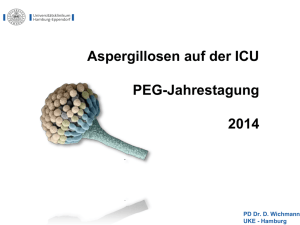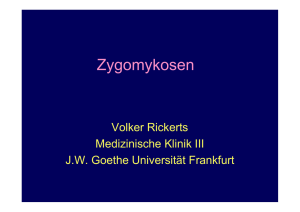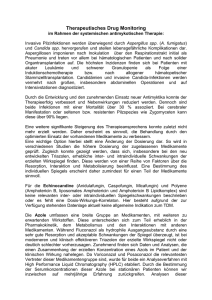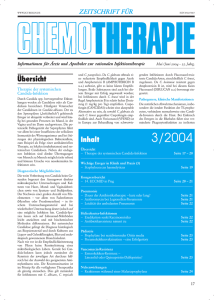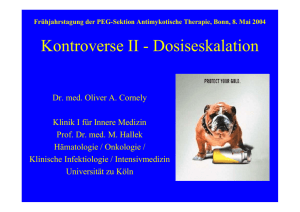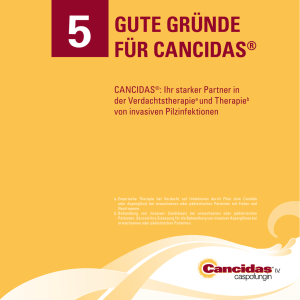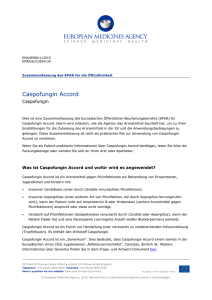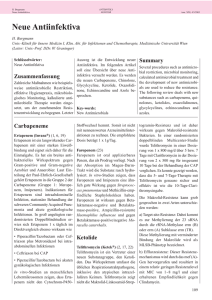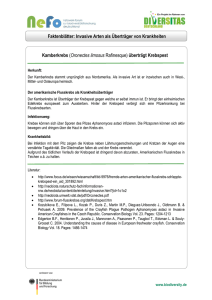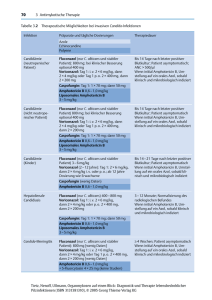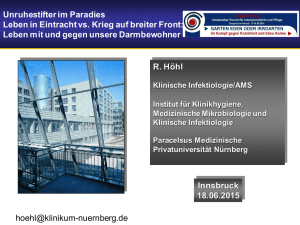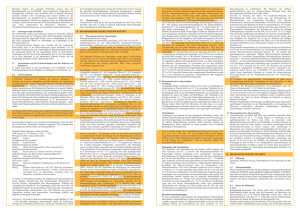Asperilluspneumonie bei Abwehrschwäche œ die Qual der Wahl
Werbung
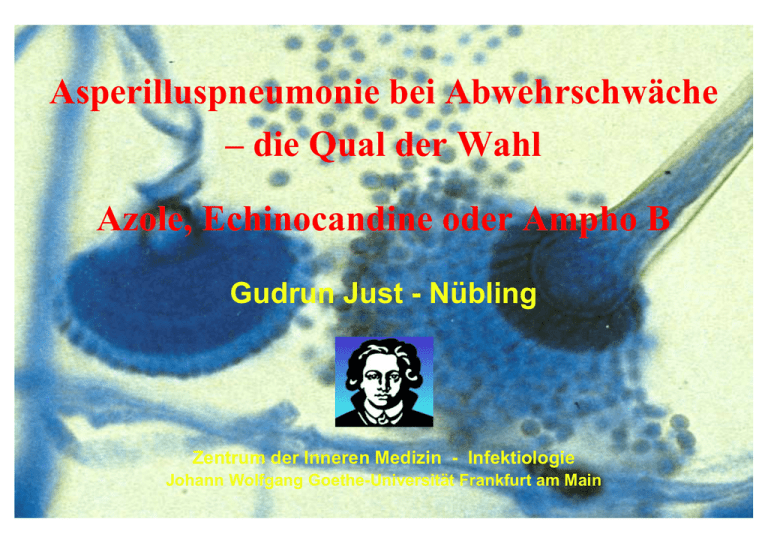
Asperilluspneumonie bei Abwehrschwäche – die Qual der Wahl Azole, Echinocandine oder Ampho B Gudrun Just - Nübling Zentrum der Inneren Medizin - Infektiologie Johann Wolfgang Goethe-Universität Frankfurt am Main Inzidenz invasiver Aspergillosen nach Knochenmarkstransplantation 14 12 allogen 10 % 8 6 4 autolog 2 0 1990 1991 1992 1993 1994 1995 1996 1997 1998 Marr CID 2002 Invasive Mykosen durch „seltene Erreger“ 16 n 14 Fusarium 12 Zygomyzeten 10 8 6 4 Scedosporium 2 0 1985-1989 1990-1994 1995-1999 Marr CID 2002 Definition invasiver Mykosen ! Sichere invasive Infektion: histopathologischer Nachweis bzw. pos. mikroskopischer Nachweis in sterilen Materialien in Assoziation mit klin. Bild ! Wahrscheinliche invasive Infektion: Wirt + Klinik + Mikrobiologie ! Mögliche invasive Infektion: Wirt + Klinik oder Mikrobiologie Ascioglu CID 02 V. Jacobi Z. Rad Uni Frankfurt Invasive pulmonale Aspergillose V. Jacobi Z. Rad Uni Frankfurt A.D.H. 1.7.97 A.D.H. 1.7.97 V. Jacobi Z. Rad Uni Frankfurt Mucor Frühinfiltrate A.D.H. 1.7.97 A.D.H. 1.7.97 V. Jacobi Z. Rad Uni Frankfurt V. Jacobi Z. Rad Uni Frankfurt Invasive pulmonale Aspergillose V. Jacobi Z. Rad Uni Frankfurt V. Jacobi Z. Rad Uni Frankfurt Mucor Infiltrate V. Jacobi Z. Rad Uni Frankfurt Nocardiose Zwei Jahre nach Nieren-Tx Labor-Diagnostik von Mykosen ! Direkte Mikroskopie von Körperflüssigkeiten ! Histologie ! Kultur ! Serologie: Antigen-Nachweis ! PCR-Methoden Systemisch wirksame Antimykotika Polyen Amphotericin B Deoxycholat Neuere Präparationen • Liposomales Ampho B • ABCD • ABLC (Ambisome®) (Amphocil®) (Abelcet®) Pyrimidin 5-Fluorocytosin (Ancotil®) Imidazole Miconazol Ketoconazol Fluconazol Itraconazol Voriconazol (Daktar®) Caspofungin (Cancidas®) Terbinafin (Lamisil®) Echinocandin Allylamin (Nizoral®) (Diflucan®) (Sempera®) (Vfend®) Neue Antimykotika Triazol-Derivate Echinocandine Polyen Posaconazol Ravuconazol (Schering) Micafungin Anidulafungin (Fujisava) Liposomales Nystatin (BMS) (Versicor) (Avonex) In vitro - Wirksamkeit gegenüber Sproß- bzw. Hefepilzen Erreger C. albicans C. glabrata C. krusei C. tropicalis C. paraspilosis Itraconazol Fluconazol Voriconazol Caspofungin + (+) (-) + + + (+) + + + + + + + + + + + (+) Cryptococcus neof. + + + - Trichosporon asahii + + + - In vitro - Wirksamkeit gegenüber Schimmelpilzen Erreger Aspergillus spp. Itraconazol Fluconazol Voriconazol Caspofungin + - + + Zygomyceten (+) - - - Scedosporium / Pseudallescheria (+) - + - - - + - Fusarium Bisherige Standardtherapie bei AspergillusMucorpneumonie Amphotericin B evt. plus Ancotil Probleme der kAmB-Therapie ! ! Hohe Rate unerwünschter Wirkungen – vorzeitiges Absetzen oftmals notwendig D.W. Bates CID 2001: bei 30% akutes Nierenversagen und 54% Mortalität in dieser Gruppe ! Intensives Monitoring ! Zentraler Venenkatheter ! Keine orale Gabe Liposomales Amphotericin B ! Mehrere offene und kontrollierte Studien ! Trend zur höheren Effektivität im Vergleich zu kAmB ! Empirische Tx: LAmB vs kAmB kein signifikanter Unterschied, weniger Durchbruch-Infekt. unter LAmB Walsh NEJM 2004 ! Bessere Verträglichkeit ! Höhere Dosierungen möglich Walsh AAC 2001 ! Hohe Therapiekosten ! Wichtige Vergleichssubstanz für neue Antimykotika Liposomales Amphotericin B ! Leenders Brit J Hematol 1998: Vergleich von kAmB (1mg/kg/d) mit L-AmB (5mg/kg/d) bei neutropenischen Pat. mit nachgewiesenen Mykosen ! 66 pat. Auswertbar (Schimmelp.32/26; Candida 3/7) ! Ansprechen nach Studienende: kAmB 19/34 (56%) L-AmB 21/32 (66%) Aspergillus-Pneumonie: 11 (42%) mit L-AmB 6 ( 21%) mit k-AmB Invasive pulmonale Aspergillose bei immunsuppremierten Patienten Intravenöses Itraconazol ! 31 Patienten n = 28 Hämatolog. Grunderkrankung (3 allog.BMT, 3 autolog. BMT, 19 Neutropenie) n = 3 chron. granulomatöse Erkrankung n = 1 AIDS ! Itra i.v. Tag 1+2 400mg, 12 Tage 200mg ! Anschluss- Tx mit Itra oral 400 mg/Tag 12 Wochen ! 37 Patienten zuvor antimykotische Therapie Caillot et al. CID, October 2001 Intravenous Itraconazole Treatment of invasive pulmonary aspergillosis Clinical Outcome Invasive Aspergillose Voriconazol • • • • • • offene, nicht vergleichende Studie 116 immunsupprimierte Patienten 41% gesicherter Infektion, 59 % mit Verdacht auf Infektion Dosis: i.v. 3 mg/kg/Tag 2x (loading dose 6mg/kg/Tag 2x) Dauer: 6-27 Tage oral 200mg/Tag 2x bis zu 24 Wochen offene, nicht vergleichende Studie Ergebnis: CR + PR Gesamtansprechrate Primärtherapie ‘Salvage‘-Therapie Pulmonal und Tracheobronch. (n=84) Cerebral (n=19) Disseminiert (n=6) D. Denning, CID 2002 48 % 59 % 38 % 60 % 16 % 50 % Voriconazol • Behandlung von invasiven Mykosen bei Versagen bzw. Unverträglichkeit der Primärtherapie (n=273) • Gesamtansprechrate 50% Aspergillose • Lunge 40/86 (46,5%) ± oral Vori 5 mg / kg / d alle Manifestationen 62/142 (43,7%) Fusariose 5/11 (45,5%) Scedosporiose 3/10 (30%) Gute Verträglichkeit, Sehstörungen bei 22,8%! JR Perfect CID 2003:36,1122-1130 Voriconazole vs. Amphotericin B Primary TX in invasive Aspergillosis • Randomized study Ampho B 1-1.5 mg / kg day VRC 6 mg / kg (2 doses) " 4 mg / kg q 12 h " followed by other licensed antifungal drugs • Underlying diseases allo BMT: auto BMT / hematological disease: other: • 26 % VRC , 23 % Ampho B 56 % VRC , 63 % Ampho B 18 % VRC , 14 % Ampho B 392 patients were enrolled over 3 years in 92 centers in 19 countries R.Herbrecht et al. N Engl J Med, August 2002 Herbrecht, NEJM 02 Ansprechen auf antimykotische Therapie Herbrecht, NEJM 02 Voriconazole vs. Amphotericin B Primary TX in invasive Aspergillosis Voriconazole Ampho B N = 144 N = 133 Pulmonary IA 85.4 % 88 % Dissem. IA 2.8 % 0.8 % CNS 3.5 % 3.8 % CR / PR 52.8 % 31.6 % Survival 70.8 % 57.9 % Clinical outcome week 12 R.Herbrecht et al. N Engl J Med, August 2002 Caspofungin H 2N OH NH HO H2N O N H H N N H O HN H O H HO O HO NH O H H N H OH HO O O OH N OH Caspofungin in Adults with IA Refractory or Intolerant to AMB ± Azoles • Refractory: Progression of disease or failure to improve despite therapy with at least 7 days of standard antifungal therapy (AMB, L-AMB, any azole with activity against Aspergillus) • Intolerant: Doubling of creatinine or creatinine ≥2.5 mg/dl; other significant intolerance to AMB or L-AMB Maertens J et al, 40th ICAAC, abstr #1103 (2000) Caspofungin in Adults with IA Refractory or Intolerant to AMB ± Azoles Patients Enrolled ! n = 81 enrolled, 56 evaluated by external expert panel # TJ Walsh, DW Denning, TF Patterson ! Proven (39) or probable (17) IA ! Pulmonary (40), disseminated (10) or single-organ (6) aspergillosis ! Refractory (46): 70% > 14 d, 50% > 21d prior therapy ! Intolerant (10): 9/10 < 14 d prior therapy Maertens J et al, 40th ICAAC, abstr #1103 (2000) Caspofungin in Adults with IA Refractory or Intolerant to AMB ± Azoles Response (1) ! Response (PR/CR): ! overall 41% ➜ Complete response ! ! ! ! 5.6% in pts. with >7 days caspofungin (45) in pts. with AMB/azole refractory IA in pts. intolerant to AMB/azole in pts. with pulmonary aspergillosis • with definite pulmonary aspergillosis (22) ! in pts. with disseminated aspergillosis 49% 34% 70% 46% 40.9% 20% Maertens J et al, 40th ICAAC, abstr #1103 (2000) Caspofungin in Adults with IA Refractory or Intolerant to AMB ± Azoles Response (2) ! Response (PR/CR): ! in neutropenic pts. (11) 18.2% ! in non-neutropenic pts. 46.5% ! in pts. with steroids < 20 mg/d (32) 46.9% ! in pts. with steroids ≥ 20 mg/d 31.8% ! after 4 weeks follow-up (54) 29.6% Maertens J et al, 40th ICAAC, abstr #1103 (2000) Caspofungin in Adults with IA Refractory or Intolerant to AMB ± Azoles: Safety ! Drug-related clinical AEs were uncommon (13.6%) ! ! ! ! fever (3.4%) phlebitis/thrombophlebitis (3.4%) nausea/vomiting (3.4%) Drug-related laboratory AEs also occurred uncommonly (15.6%) ! increased eosinophils (3.4%) ! 47% treated for > 28 days (up to 162 days) without the development of new drug-related AEs ! 17 pts have received concomitant caspofungin and tacrolimus therapy without the development of drug-related increases in hepatic transaminases Maertens J et al, 40th ICAAC, abstr #1103 (2000) Caspofungin in Adults with IA Refractory or Intolerant to AMB ± Azoles Update ICAAC 2002 ! n = 90 enrolled, 83 evaluated ! Definite IA 64 %, probable 36 % Ergebnis: CR + PR Pulmonary (N=64) Disseminated (N=13) Single Organ (N=6) Overall (N=83) Tx > 7 days (N=66) 32 3 2 37 37 (50.0 %) (23.0 %) (33.0 %) (44.6%) (56.1 %) Durchbruch-Infektion unter Voriconazol ! ! ! ! ! ! ! September 2002 – Juni 2003: 124 SCT 4 Patienten mit AML, CML (n=2), CMML Durchbruch-Infektion mit Zygomyceten, median 125 Tage 3 x Vori-Prophylaxe, 1 x Vori-empirische Therapie alle Patienten GvHD Manifestation: NNH: n=1 Lunge: n=3 Haut: n=1 alle Patienten verstorben Marty F, NEJM, Feb 26, 2004 Durchbruch-Infektion unter Voriconazol ! Bei 4 Patienten nach allogener Stammzell-Transplantation + GVHD Mucor-Infektion unter Vori-Prophylaxe Siwek CID August 04 ! ‚Break -Through‘ Infektion bei 13 von 139 mit Vori behandelten Patienten n allogener Stammzell-Tx: n=6 Zygomyceten; n=4 C.glabrata Imhof CID September 04 Zulassungs-Bedingungen Voriconazol Vfend ® Fluconazol-resistente schwere Candida-Infektionen Versagen der Primär-Therapie bei Mk-0991 Caspofungin Primär für Aspergillus-Infektionen Fusarium, Scedosporium, Pseudallescheria ® Aspergillus-Infektionen Invasive Candida-Infektionen Empirische Therapie Vor- und Nachteile neuer Antimykotika Voriconazol Vorteile • Breites Wirkungsspektrum, inklusive non-albicans, Aspergillus, Fusarium, Scedosporium, Pseudallescheria • Oral und i.v. Nachteile • • • Keine ausreichende Aktivität gegenüber Zygomyceten • Interaktionen mit anderen wichtigen Medikamenten i.v.-Gabe durch Cyclodextrin limitiert # Krea > 2mg/dl bzw. Hämodialyse Häufiges Auftreten von Sehstörungen bzw. Halluzinationen, potentielle Lebertoxizität Vor- und Nachteile neuer Antimykotika Caspofungin Vorteile • • • • Breites Wirkungsspektrum, inklusive Aspergillus und non-albicans-Arten Vergleichsweise geringe Interaktion mit anderen Medikamenten Bislang gute Verträglichkeit in Studien 1x tägliche Dosierung Nachteile • • • • • Keine ausreichende Aktivität gegenüber vielen Zygomyceten-Arten ungenügende Wirksamkeit gegenüber Cryptococcus Nur i.v.-Applikation Dosisanpassung bei Leberinsuffizienz Kaum ZNS-Penetration Therapie der invasive Aspergillus-Pneumonie Voriconazol 2 x 4 mg/ kg/ Tag (loading 2 x 6 mg/ kg/ Tag) Ampho B 0,8 – 1 mg/ kg/ Tag, Lipo AB 3 – 6 mg/ kg/ Tag Alternativ: Caspofungin 50 mg (loading 70 mg) Nachbehandlung: Voriconazol, Itraconazol Caspofungin ! Semisynthetischer Abkömmling von: Pneumocandin Bo Ein Produkt von Glarea lozoyensis ! Strukturklasse: Echinocandin ! Wirkmechanismus: Glucan-Synthese-Inhibition ! Generische Klasse: Lipopeptid ! Merck MK# : MK-0991 ! Generischer Name: Caspofunginacetat Therapie invasive AspergillusInfektion ! Lunge: Voriconazol 2 x 4 mg/ kg/ Tag (loading 2 x 6 mg/ kg/ Tag) Ampho B 0,8 – 1 mg/ kg/ Tag, lipo AB 3 – 6 mg/ kg/ Tag Alternativ: Caspofungin 50 mg (loading 70 mg) Nachbehandlung: Voriconazol, Itraconazol ! CNS: Lipo-AB 3 – 6 mg/ kg/ Tag Voriconazol, evtl. Kombination ! NNH: => operative Sanierung Voriconazol, Ampho B oder lipo-AB Reserve: Caspofungin SCH 56592 ! ! ! ! Triazol-Antimykotikum mit breitem Wirkungsspektrum Aspergillus spec., Rhizopus sp.,Candida spec., insbes. Nonalbicans-Stämme, C. neoformans, Pseudallescheria boydii, Histoplasma, Blastomyces, Dermatophyten. orale ( i.v ) Applikation in vitro Tests: ! ! ! Azole: 4-8x höhere Wirksamkeit gegen Aspergillus spec bis zu 8fach höhere Aktivität gegen Candida Ampho B: 4-16 fach höhere Aktivität gegen Aspergillus spec. gleiche Aktivität gegen Rhizopus spec. Tiermodell: bessere Wirksamkeit gegen C. neoformans als Fluconazol Efficacy of caspofungin in neutropenic and non- neutropenic patients: a case-documentation On behalf of the group: Axel Glasmacher (Univ. Bonn, Germany) Gudrun Just-Nübling (Univ. Frankfurt, Germany) Caspofungin Case-Documentation: Purpose ! To evaluate the clinical use of caspofungin ! ! ! ! in any indication in which the drug is clinically used by decision of the treating physician without the restrictions of inclusion/exclusion criteria most cases where treated prior to caspofungin‘s authorisation in Germany with a comprehensive questionaire focusing on • the diagnosis of the fungal infection • toxicity and comedication • outcome of the fungal infection ! Not to substitute a clinical trial Caspofungin plus liposomales Ampho B bei refraktärer Aspergillus-Pneumonie • 14 hämatologische Patienten mit Aspergillus-Infektion der Lunge (2 Pat. gesichert 12 Pat. Verdacht) 1 Patient gleichzeitig C. tropicalis-Fungämie • AML n=9 ALL n=2 biphenotypische Leukämie, CLL, MDS je n=1 • Initiale Therapie: • Mediane Dauer der initialen Ampho B-Therapie 15 (4-64) Tage Ergebnis: Ampho B n=6 lipo Ampho B n=8 Ampho B + Itra n=5 komplette/partielle Heilung 57 % (8/14) 4 Pat. nahezu völlige Remission Mediane Dauer der Kombination 23 (9-48) Tage Aliff T, et al.: ASH 2001 Abstract 1381 Antimykotische Kombinations-Therapie Neue Kombinationen • Caspofungin plus Itraconazol 2 Pat. mit invasiver Aspergillose (1x A. terreus, 1x Salvage) # Erfolgreiche Behandlung M.A. Rubin, CID 2002 • Caspofungin plus Itraconazol Patientin mit Diabetes und metastasierendem Pankreas-Karzinom nach Chemothertapie, schwere progrediente kutane Paecilomyces lilacinus-Infektion, Non-Response auf Itra alleine # Erfolgreiche Behandlung A. Safdar, CID 2002 Antimykotische Kombinations-Therapie Neue Kombinationen • Ampho B plus Fluconazol (n=107) versus Fluconazol (n=104) bei Candidämie, prosp. randomisierte Studie # Schnellere Sterilisierung der BK, gleiche Mortalität Rex et al. ICAAC, J-681a • Ampho B (n=10) versus Ampho B plus Itraconazol (n=11) bei invasiver Aspergillose, retrospektive Studie # höhere Heilungsrate mit Kombination (82%) vs. Mono-Tx (50%) Popp et al. (1999), Int J Infect Dis Invasive pulmonale Aspergillose V. Jacobi Z. Rad Uni Frankfurt Invasive pulmonale Aspergillose V. Jacobi Z. Rad Uni Frankfurt Mucor Infiltrate V. Jacobi Z. Rad Uni Frankfurt Wann sollte man an eine Pulmonale Mucormykose denken? V. Jacobi Z. Rad Uni Frankfurt Mucor: Infiltratives Wachstum A.D.H. 1.7.97 A.D.H. 1.7.97 U.K. 25.11.98 A.D.H. 1.7.97 U.K. 30.12.98 V. Jacobi Z. Rad Uni Frankfurt Mucor: Tumorähnliches Wachstum V. Jacobi Z. Rad Uni Frankfurt Mucor Frühinfiltrate: „Nestzeichen“ V. Jacobi Z. Rad Uni Frankfurt Mucor Frühinfiltrate A.D.H. 1.7.97 A.D.H. 1.7.97 V. Jacobi Z. Rad Uni Frankfurt Mucor - Mykose 17.2.97 10.3.97 V. Jacobi Z. Rad Uni Frankfurt Voriconazol Pharmakokinetik • Orale Gabe • • • • • • • • • Nichtlineare Pharmakokinetik # schnelle Resorption, Tmax < 2 Stunden # Bioverfügbarkeit > 96 % Eiweißbindung ca. 58 % Wasserlöslichkeit schlecht Serumhalbwertzeit 6-12 Stunden starke Metabolisierung Clearance über Leber, < 5 % unverändert im Urin Gute Gewebediffusiuon Liquorgängigkeit 40 - 70 % Applikation oral und i.v. 2x täglich Interaktionen mit Voriconazol Medikament Vorgehen Omeprazol halbe Dosierung Rifabutin + Phenytoin Erhöhung der Voriconazol-Dosis # 5 mg / kg i.v., 400 mg oral / 2x täglich Tacrolimus 1/3 der initialen Tacrolimus-Dosis # Bestimmung der Serumkonzentration Cyclosporin 1/2 der initialen Cyclosporin-Dosis # Bestimmung der Serumkonzentration Warfarin PT-Kontrolle Kontraindikation Voriconazol • • • • Terfenadin Astemizol Cisaprid Pimozid • • • • Chinidin Carbamazepin Sirolimus Rifampicin • • Phenobarbital Ergot-Akaloide Caspofungin Wirkmechanismus ! Inhibition der β-(1,3)-D-Glucan-Synthese ! Störung der Zellwandintegrität vieler Pilze ! Kommt in menschlichen Zellen nicht vor ! Candida spp.: β-1,3- (~40-50%) & β-1,6-Glucan ! Aspergillus spp.: Hyphen überwiegend β-1,3-Glucan ! Wirksamkeit korreliert möglicherweise mit dem Gehalt an β-1,3-Glucan Caspofungin Pharmakokinetik ! Gut wasserlöslich, schlechte orale Resorption (<1%) ! t1/2β ca. 9-11 h, Einmal-Dosierung ! Hepatischer Metabolismus ! Relevante Interaktion nur mit Ciclosporin A ! Geringe Interaktion mit Tacrolimus (Cmin$ 26 %) ! Dosis-Erhöhung (auf 70 mg / d) bei Kombination mit: Efavirenz, Nelfinavir, Dexamethason, Rifampicin, Phenytoin, Carbamazepin ! Anreicherung in Leber und Niere, geringe Konzentration in ZNS und Urin Caspofungin Dosierung ! ! Aufsättigungsdosis (Tag 1) Erhaltungsdosis 70 mg / Tag 50 mg / Tag bei > 80 kg KG 70 mg / Tag Child-Pugh 7-9 35 mg / Tag Max. tolerable Dosis noch nicht bekannt Caspofungin Pharmakokinetik: klinische Daten ! AUC-Anstieg bei Niereninsuffizienz ! ! ! ! Creat.-Clear. 80-50 ml/min: 49-31 ml/min: 30- 5 ml/min: HD/HF: 6% (⇑ ⇑) (n=7) 12% (⇑ ⇑) (n=8) 61% (⇑ ⇑) (n=9) 47% (⇑ ⇑) (n=9) Dosisanpassung nicht empfohlen Nicht dialysierbar AUC-Anstieg bei Leberinsuffizienz: ! ! ! CHILD-Pugh5-6: 43% (⇑ ⇑), CHILD-Pugh 7-9: 72% (⇑ ⇑) Bisher keine Gabe bei Bilirubinerhöhung Dosisanpassung bei CHILD-Pugh 7-9: 70 mg d1 → 35 mg/d Sable ICAAC 2000 Caspofungin Pharmakokinetik: Zusammenfassung ! Keine orale Resorption ! Klinisch relevante Halbwertszeit: ca. 10h ! Einmaldosierung ! Hepatischer Metabolismus (Cave: Leberinsuffizienz) ! Relevante Interaktion nur mit Ciclosporin A ! Anreicherung in Leber und Niere, geringe Konzentration in ZNS und Urin Voriconazole Combined with Echinocandins ! Checker-board technique. 10 A. fumigatus isolates Drug Combination ! Interaction MK + AMB Synergistic FK + AMB Synergistic VCZ + FK Additive VCZ + MK Additive VCZ + AMB Indifferent Two drug combinations of an echinocandin with a polyene or an azole may be more effective against A. fumigatus than using them individually. Manavathu et al. (2001). IDSA, 39th, San Francisco Voriconazole vs. Amphotericin B Primary TX in invasive Aspergillosis Voriconazole Ampho B N = 144 N = 133 Pulmonary IA 85.4 % 88 % Dissem. IA 2.8 % 0.8 % CNS 3.5 % 3.8 % CR / PR 52.8 % 31.6 % Survival 70.8 % 57.9 % Clinical outcome week 12 R.Herbrecht et al. N Engl J Med, August 2002 Angriffsorte von Antimykotika in der Pilz-Zelle
